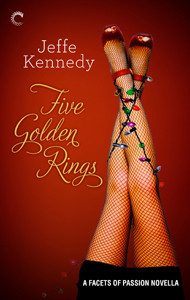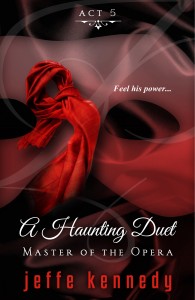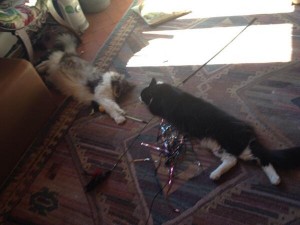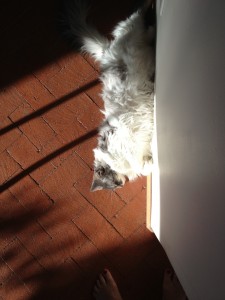 I’m over at the Contemporary Romance Cafe today, talking about book boyfriends. What? You know you have one. Or ten.
I’m over at the Contemporary Romance Cafe today, talking about book boyfriends. What? You know you have one. Or ten.

Five Golden Rings Coming in Two Weeks!
 Look at all of these yummy buy links. So much fun for the clicky-clicky preorder! 😀
Look at all of these yummy buy links. So much fun for the clicky-clicky preorder! 😀
At What Point Do You Dig In to Protect Your Writing Process?
 A shot from Los Angeles last week and lunch with the delightful Lynda Ryba (@fishwithsticks). She’s going to be helping out with my Facebook Author Page, so we should see VAST improvements in that! (Really, it couldn’t get worse…)
A shot from Los Angeles last week and lunch with the delightful Lynda Ryba (@fishwithsticks). She’s going to be helping out with my Facebook Author Page, so we should see VAST improvements in that! (Really, it couldn’t get worse…)
What with it being NaNoWriMo (National Novel Writing Month, if you live under a rock – basically you commit to writing 50,000 new words during November), I’ve been thinking a lot about the writing process. Quite a few people wanted me to participate in NaNoWriMo. I could, because I’m seriously drafting book 3 in Covenant of Thorns right now. (I think it will be called Rogue’s Paradise.) I’m almost 20K into it and will almost certainly write at least 50K during this month. And I’d like to be supportive – I really would. Some of the newbie writers in my local chapter are doing it and I can see it would be helpful of me to join in. I like being supportive that way.
Except I said no.
Why? Because I *have* to turn in this book – complete and polished – by December 31, according to my contract. Worse, my editor is going on this long trip to New Zealand (yes, we hate her) and really wants the manuscript by December 25, so she can take it with her. Really a week doesn’t make that much difference, but it makes the deadline ever so slightly tighter. I cannot miss this deadline.
But Jeffe, you say – isn’t that all the more reason to do NaNo, to crank on getting those words down?
See, it’s really not.
Over the past several years, I’ve put a lot of effort and concentration into learning and refining my writing process. I say “learning” because I really believe we all have an organic process that we have to discover and love. It’s rough to go against that. I’ve now written six novels and novellas according to the method I’m using now. I know how much I can do each day (right now, about 2,250 words in 2-3 hours) and how long it will take me to complete the draft and then to revise. Being able to reliably create on a schedule is crucial for being a professional writer. This process is delivering for me. That makes it precious.
Which means I’m not going to mess with it.
No way.
Call me superstitious, but I’m not changing a thing.
I’m feeling much the same about workshops and classes. Now, I’m a huge believer in continuing education, lifelong learning – all that stuff. I was the girl in college who took 21 credits every semester, just because there were so many interesting classes to take. That said, I don’t have a writing degree of any sort – no English major, no MFA. I’ve taken tons of writing workshops, etc., over the years, but for the time being, I’m feeling like I want to stay away from them.
This isn’t the hip thing to say these days. Particularly not in the romance-writing community. (In fact, I don’t recall seeing this perspective much at all in the literary community. Those writers are much more apt to be protective of their process and to be vocal about it.) People love to point out when established writers come to workshops. They say things like “I’m never done learning!” and “not taking workshops can lead to stagnation.”
In fact, someone said that last to me just the other day. I threw the question out to Twitter (of course). I framed the question carefully, asking if any of the writers – especially well-established ones – found themselves staying away from classes and workshops, to protect their method. I tried to phrase it to weed out the happy “I love to take classes!” answers. Even so, I still received those responses.
@jeffekennedy Yes. I get very “I’ll do what I want!!!” about it. I always hated writing for school.
— Victoria Dahl (@VictoriaDahl) November 3, 2013
and
@jeffekennedy Definitely. It’s taken me a long time to get my process right, and I’m not messing with it now after 20 books!
— Zoe Archer (@Zoe_Archer) November 3, 2013
Another author, who preferred to remain anonymous, told me about an experience early in her writing career about “you can’t do that” that stopped her flat. She didn’t write for almost a year.
I think if I cast my net wider, I’d hear more of this kind of feedback. Because it sounds better to be enthusiastic about learning and growing, those writers who feel protective of their process might be less likely to speak up. But, I think it’s an important point – and speaks to the gal who said that not learning could lead to stagnation, a very common view – to remember that growing isn’t necessarily derived from taking workshops. There are thousands of ways to learn and grow as a writer, not the least of which is reading!
It’s certainly a fine line to walk. And it’s not that I think my process or my art is perfect. I do feel, however, that it’s working for me. I’m continuing to improve as a writer and that’s important to me.
More, I’m protective of it.
Setting and World-Building – Keep It Concise!
 I’m over at Word Whores today, discussing this great scene and talking about setting.
I’m over at Word Whores today, discussing this great scene and talking about setting.
Otter Delight
 I just returned from a conference for the Day Job that took place in Long Beach, California. The highlight was the private event at the Aquarium of the Pacific. We arrived at 7 and were able to tour all the exhibits with just our group – and have drinks at the same time! Then we had dinner with a view of an enormous, floor-to-ceiling tank. Just extraordinary.
I just returned from a conference for the Day Job that took place in Long Beach, California. The highlight was the private event at the Aquarium of the Pacific. We arrived at 7 and were able to tour all the exhibits with just our group – and have drinks at the same time! Then we had dinner with a view of an enormous, floor-to-ceiling tank. Just extraordinary.
 The jellyfish exhibits were just excellent. In the one below, the beating of the jellyfish’s cilia were highlighted, giving this super cool neon effect.
The jellyfish exhibits were just excellent. In the one below, the beating of the jellyfish’s cilia were highlighted, giving this super cool neon effect.
Also, there were Garden Eels! They plant their tails in the sand and pretend to be grass, letting their heads wave in the current, mouths ready to catch hapless fish passers-by. But possibly the very best part was the otter exhibit. Beautifully designed, the tank puts the otters right at eye level. And the lack of crowds let me get this great sequence to start your weekend off right.
But possibly the very best part was the otter exhibit. Beautifully designed, the tank puts the otters right at eye level. And the lack of crowds let me get this great sequence to start your weekend off right.
You’re welcome.
Enticing Villains, Bland Heroes and the Lure of the Bad Boy
 I’m over at Word Whores this morning, talking about whether villains can be protagonists. And yes, about Bad Boys.
I’m over at Word Whores this morning, talking about whether villains can be protagonists. And yes, about Bad Boys.
Liking the Writing, but Not Liking the Story – a Conundrum
 The combination of purple and orange in my Halloween display was serendipitous – I’ve been loving how it looks.
The combination of purple and orange in my Halloween display was serendipitous – I’ve been loving how it looks.
I’ve been reading a book by an author who writes in one of the same genres that I do, a genre I love to read. This is the second book of hers I’ve read – both of which I picked up due to enthusiastic reader responses. I didn’t like the first book, but I thought I’d give this new one a try. They’re unrelated stories. Maybe I just didn’t click with that book?
But this new one isn’t working for me either.
But in a funny way, because – as with the first one I read – I’m finishing it. Regular readers of this blog know I have the 25% rule. I commit to reading 25% of every book I pick up. If I’m not engaged by then, I can bail without guilt. (If I really hate it, I can stop before that. But most books I try to give 25% to hook me.) I have a fairly high percentage of DNFs (Did Not Finish). My reading time is precious and I don’t need to waste it on books I’m not enjoying.
In this case, I’ve kept going. Even though I *knew* by 10% in that I didn’t like the story or characters very much. It’s bizarre to me, because the writing is smooth and polished. I enjoy the author’s voice. I find her interesting in her blog posts and so forth. I’ve met her and find her to be a lovely person. I even like her story premises and get excited to read the book. As I read, however, I get that sinking sensation that I don’t like how she’s telling the story. I never emotionally engage with the characters. There’s far too much angsting and emotional retread for me and I find myself growing impatient with it all. But I still want to know how it ends.
I mentioned this on Twitter and one of my editors chimed in saying this was the most difficult kind of manuscript submission for her to deal with – the polished writing and engaging voice, but a story and characters that fail to grab her.
I realized, during this conversation, that I hear that kind of response from editors and agents all the time. I suppose I always interpreted it as a sort of faux excuse. They’ll say “love the writing, love the voice, but the story didn’t work for me.” And then they’ll add the reminder that this is just their personal opinion and someone else will likely love it.
After all this time, I suddenly get what they’re saying. You can love a writer in every way, except the actual stories they tell. And there’s nothing wrong with this.
I’ve been known to say that I love Ann Patchett’s writing so much that I don’t care what the story is about – I’ll read her regardless. Then, the unthinkable happened – I didn’t like her last book. I didn’t like what happened in the story, particularly something that occurred at the end. So, has that changed things for me? Yes. Now I’ll look at what the story is about. A minor shift perhaps.
There’s been several instances lately where authors of very popular series have ended them in unpopular ways. Charlaine Harris and her Sookie Stackhouse series is a good example. Just this week, Veronica Roth came under fire for the way her trilogy ended, prompting arguments over what authors owe readers – especially manic fans. I’ve seen numerous fans say they won’t read anything Roth writes again, because they feel they can’t trust her now. I never read the books, but – having heard the spoilers – I think, as a reader, I’d feel the same way.
At the same time, as an author, I respect her right to stay true to her vision and do as she wishes with her story.
I suppose, what this all comes around to, is what we’re “buying” when we commit to reading a book. In that link about Veronica Roth, John Green says, “Basically, I would argue that books are not primarily in the wish fulfillment business.” Yet, I know I do read so I can be transported. I do want my wishes fulfilled. I don’t expect that in life, but I do want it in my entertainment.
In the end, it’s a more or less democratic process, I suppose. We buy what we want to read. I can hope that readers enjoy what I write.
But neither team can control the other.
Life Cycles – or How I Became a Teenager Again
 House is decorated for Halloween! Always makes me happy. I’ll even be home for Halloween night this year, for the first time in a couple of years.
House is decorated for Halloween! Always makes me happy. I’ll even be home for Halloween night this year, for the first time in a couple of years.
I’m over at What the Cat Read today, with a variety of quotes about writers and cats.
The post ahead might be a bit TMI. Fair Warning.
I’ve been hitting a funny place in my life lately. Now that I’m in my late 40s, I’m looking at the whole menopause thing, though I’ve had blessedly few symptoms. More in the radar sites right now is dealing with my blood pressure. It’s just a little high. “Pre-Hypertension,” they call it. Not high enough to medicate, but high enough to be of concern. So far, I’ve been doing about everything I can. My diet is good – low fat, veggies, no fast food. I exercise. With the treadmill desk I’m walking 7-8 miles/day. No caffeine. Trying various herbs.
I recently switched practitioners and she suggested that I should go off the birth control pills, as a next step. It’s funny because I’ve been on the pill for over 30 years. I started on it when I was 16 and had met the guy I wanted to lose my virginity to. And I’ve never looked back. Taking the pill every night has acted as a calendar for my adult life. Likely what I’ll do is get a copper IUD. I still have my biases left over from the IUD horror stories of the 80s, but apparently they’re tons better now. Funny to me that I never tracked those changes.
For the time being, however, we’re using condoms. The other day, I went to the pharmacy and bought a box – for the first time in my whole entire life.
Because, back in my youthful, non-monogamous days, STDs weren’t emphasized so much. AIDS really became a major concern by my junior year in college. But even then, we tended to think in terms of exposure and whether or not we’d been tested. Because I was on the pill and reasonably discriminating in my lovers, we just didn’t use condoms. In fact, I never had sex with a condom until I met David and I was on antibiotics at one point, that could interfere with the efficacy of the pill.
So I never had that rite of passage until just the other day. And yes, I felt totally like a teenager. Plus, with my ovaries and uterus waking up from their long sleep and positively throbbing, I feel like I did when I first started getting my period when I was 12. Also, “they” seem to be right that the pill suppresses desire. While I never felt like I didn’t want sex, now… let’s just say I’m feeling teenagerish that way, also.
Not really what I thought I’d experience in my late 40s, but also cool in many ways, to revisit my youthful feelings. I feel like I’ve come full circle.
And that’s a nice place to be.
Discovering the Power of the Disabled Protagonist
Isabel was in this spot before the sun sank low enough to hit her. Excellent strategy.
This week’s topic over at Word Whores is The Physically Disabled Protagonist. Keen-eyed readers might remember that I wrote “Discovering the Power of the Disabled Protagonist” back in August on the Here Be Magic group blog. So, I’m totally taking the bye and reproducing it. Hie on over if you missed it last time!
Why We HAVE to Program in Mental Downtime
 I emerged from my office yesterday to happen upon this scene. Both cats were passed out, nearly nose-to-nose, amidst the detritus of cat toys. As one Facebook commenter pointed out, they look like they partied hard all night.
I emerged from my office yesterday to happen upon this scene. Both cats were passed out, nearly nose-to-nose, amidst the detritus of cat toys. As one Facebook commenter pointed out, they look like they partied hard all night.
Cats are admirable for their ability to relax. They can go from 60 to 0 in a blink. Wild rocket-cat to full-out, belly-up sprawl. There’s fascinating biology and animal behavior theories around this. Because felines are the most efficient predators out there, they have a lot of down time. They basically snooze so much because they can.
Wouldn’t that be nice, if we could be so super-productive with our time that we could spend the rest of it goofing off?
That’s part of the thrust of this fascinating article from Scientific American about why our brains physiologically require downtime. This bit, in particular, stood out for me:
Based on his own work and a thorough review of the relevant research, Ericsson has concluded that most people can engage in deliberate practice—which means pushing oneself beyond current limits—for only an hour without rest; that extremely talented people in many different disciplines—music, sports, writing—rarely practice more than four hours each day on average; and that many experts prefer to begin training early in the morning when mental and physical energy is readily available.
I also liked this:
Many recent studies have corroborated the idea that our mental resources are continuously depleted throughout the day and that various kinds of rest and downtime can both replenish those reserves and increase their volume.
and
By adulthood, most of us have adopted the habit of sleeping through the night and staying awake for most or all of the day—but this may not be ideal for our mental health and is certainly not the only way people have slept throughout history. In somewhat the same way that hobbits in Tolkien’s Middle Earth enjoy a first and second breakfast, people living without electricity in preindustrial Europe looked forward to a first and second sleep divided by about an hour of crepuscular activity. During that hour, they would pray, relieve themselves, smoke tobacco, have sex and even visit neighbors. Some researchers have proposed that people are also physiologically inclined to snooze during a 2 P.M. to 4 P.M. “nap zone”—or what some might call the afternoon slump—because the brain prefers to toggle between sleep and wake more than once a day. As far back as the first century B.C. the Romans regularly took midafternoon breaks, which they called meridiari from the Latin for midday. Under the influence of Roman Catholicism, noon became known as sexta (the sixth hour, according to their clocks), a time for rest and prayer. Eventually sexta morphed into siesta.
See, I tend to be the kind of person who works non-stop. I’m not much of a napper. I’ve always been blessed with good concentration – which is a handy skill for a novelist – but it means I can work for hours on end without noticing the passage of time. I’ll emerge from the trance utterly exhausted. And yes – it’s almost never more than four hours.
I rarely take this exhaustion seriously because, after all, I was only writing. Just thinking and keyboarding. It’s not like I was working four hours digging ditches.
But what all this research implies is that, energetically, it is the same.
So I love this concept of introducing deliberate mental downtime in my days. I think it’s so true that, as Americans, we get into this mode of working All The Time. For my day job, I work for a consulting firm much like the one cited in the article. During the recently ended government shutdown, we could not work on our projects – because our work is almost entirely for the EPA, which was deemed non-essential. I took leave and spent time on writing (of course), but it was fascinating to see so many of my colleagues not know what to do with themselves. I know of two gals who took vacation leave and went to work in the soup kitchen, just to feel productive. That’s great that they wanted to do it, but my first thought was, take vacation leave and go rest.
A lot of people in my company don’t use their vacation leave – and they’re proud to say so.
Thus, I’m working on freeing up my work habits and introducing deliberate rest time. It turns out that even closing my eyes for a few minutes should restore my mind. I also need to walk away from the computer more often – mini-breaks to switch up those energy-draining activities.
Oh and hey – it’s almost the weekend! Let’s all go do some restorative activities!
